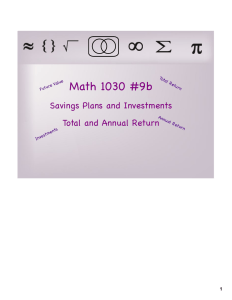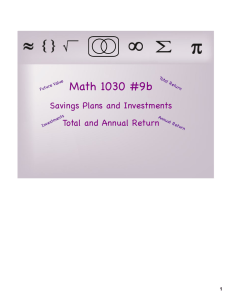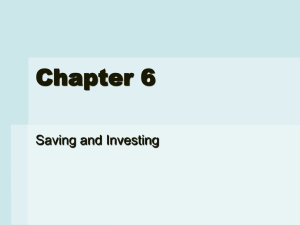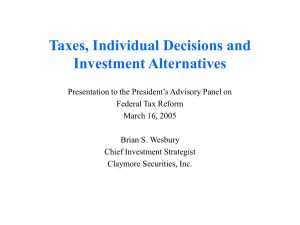Session #7 – Basics of Investing
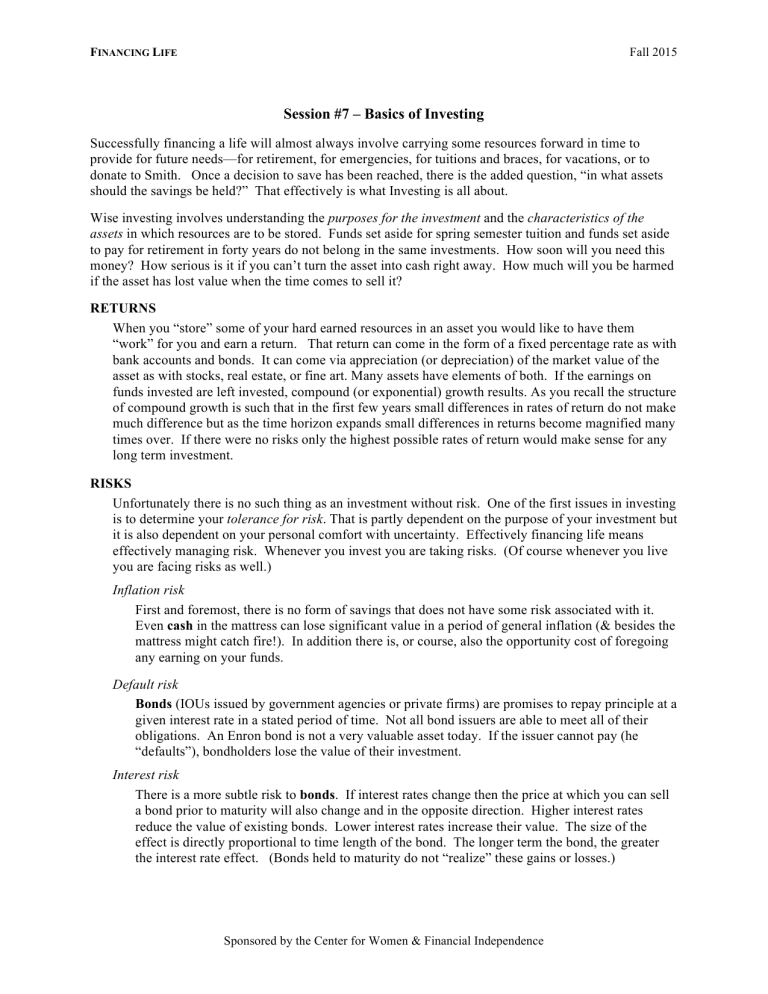
F
INANCING
L
IFE
Fall 2015
Session #7 – Basics of Investing
Successfully financing a life will almost always involve carrying some resources forward in time to provide for future needs—for retirement, for emergencies, for tuitions and braces, for vacations, or to donate to Smith. Once a decision to save has been reached, there is the added question, “in what assets should the savings be held?” That effectively is what Investing is all about.
Wise investing involves understanding the purposes for the investment and the characteristics of the assets in which resources are to be stored. Funds set aside for spring semester tuition and funds set aside to pay for retirement in forty years do not belong in the same investments. How soon will you need this money? How serious is it if you can’t turn the asset into cash right away. How much will you be harmed if the asset has lost value when the time comes to sell it?
RETURNS
When you “store” some of your hard earned resources in an asset you would like to have them
“work” for you and earn a return. That return can come in the form of a fixed percentage rate as with bank accounts and bonds. It can come via appreciation (or depreciation) of the market value of the asset as with stocks, real estate, or fine art. Many assets have elements of both. If the earnings on funds invested are left invested, compound (or exponential) growth results. As you recall the structure of compound growth is such that in the first few years small differences in rates of return do not make much difference but as the time horizon expands small differences in returns become magnified many times over. If there were no risks only the highest possible rates of return would make sense for any long term investment.
RISKS
Unfortunately there is no such thing as an investment without risk. One of the first issues in investing is to determine your tolerance for risk . That is partly dependent on the purpose of your investment but it is also dependent on your personal comfort with uncertainty. Effectively financing life means effectively managing risk. Whenever you invest you are taking risks. (Of course whenever you live you are facing risks as well.)
Inflation risk
First and foremost, there is no form of savings that does not have some risk associated with it.
Even cash in the mattress can lose significant value in a period of general inflation (& besides the mattress might catch fire!). In addition there is, or course, also the opportunity cost of foregoing any earning on your funds.
Default risk
Bonds (IOUs issued by government agencies or private firms) are promises to repay principle at a given interest rate in a stated period of time. Not all bond issuers are able to meet all of their obligations. An Enron bond is not a very valuable asset today. If the issuer cannot pay (he
“defaults”), bondholders lose the value of their investment.
Interest risk
There is a more subtle risk to bonds . If interest rates change then the price at which you can sell a bond prior to maturity will also change and in the opposite direction. Higher interest rates reduce the value of existing bonds. Lower interest rates increase their value. The size of the effect is directly proportional to time length of the bond. The longer term the bond, the greater the interest rate effect. (Bonds held to maturity do not “realize” these gains or losses.)
Sponsored by the Center for Women & Financial Independence
F
INANCING
L
IFE
Fall 2015
Principle Risk
The value of stocks or equities is determined by the market and its expectations about the future profits of particular companies or industries (or the whole macro economy). Stocks exhibit wide swings up and down in erratic patterns and can lose or gain significantly in a short period of time.
Over very long periods of time stocks have always performed very well but they are a highly risky place for funds that you will need for important purposes in a short time.
LIQUIDITY
Different assets have different degrees of liquidity, a measure of how easily and quickly the value can be extracted and converted into cash . A U.S. Treasury bond or 100 shares of IBM can be sold on well-organized markets in a matter of minutes. There are minimal transactions costs and buyers are easy to find. If you own an apartment building in Chicago, turning it into cash may take months or years and there will likely be significant costs in terms of commissions, taxes and fees. The timeshare resale industry thrives because of illiquidity.
TAX CONSEQUENCES
The returns on different classes of assets are taxed in different ways. Interest on bonds, CDs, or bank accounts is taxed as regular income. Interest earned on municipal bonds is free of federal income tax. Capital gains are treated as income, but they are not taxed until they are “realized” (i.e., when you sell the asset), and then they are taxed at a lower rate than regular income. Capital gains on your primary residence (up to $500,000) are never taxed. In the final analysis it is the after tax returns that you should consider in deciding on a portfolio—unless your primary motivation is to support your
Uncle Sam in his lavish life style.
CHOOSE WISELY—DIVERSIFY BROADLY
Obviously the best choice is a very high return asset with zero risk, perfectly liquidity and no taxes.
The bad news is that there is no such thing. To some degree there is a trade-off between risk and return — higher returns are a reward for accepting higher risks . To some degree returns can be defended while risks can be reduced by carefully diversifying your investments.
Sponsored by the Center for Women & Financial Independence




